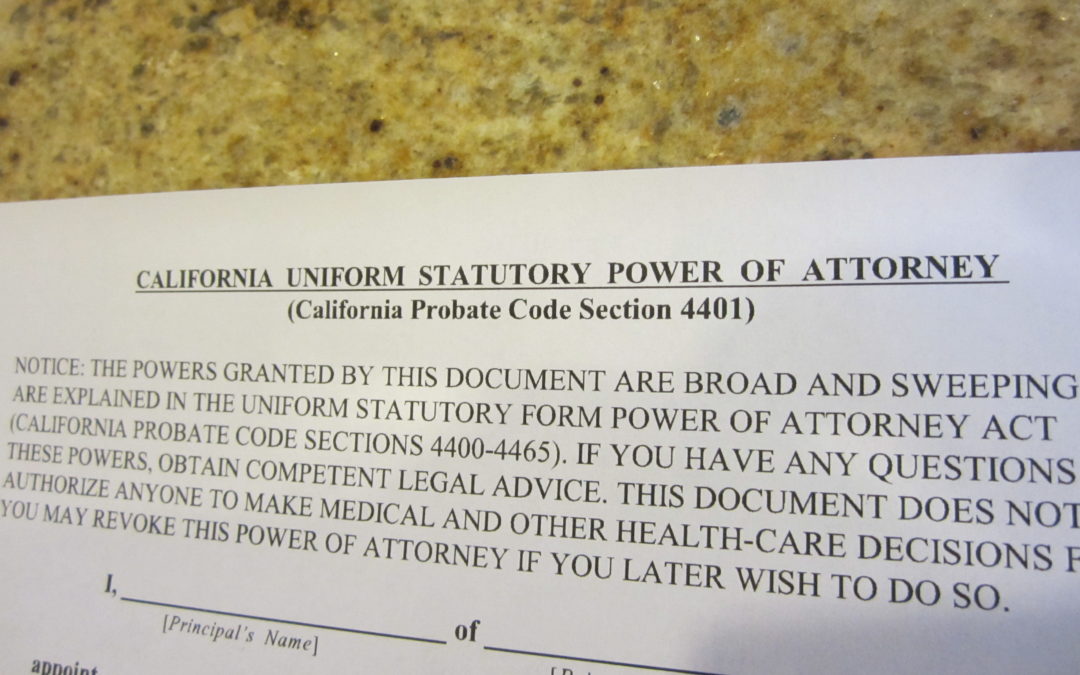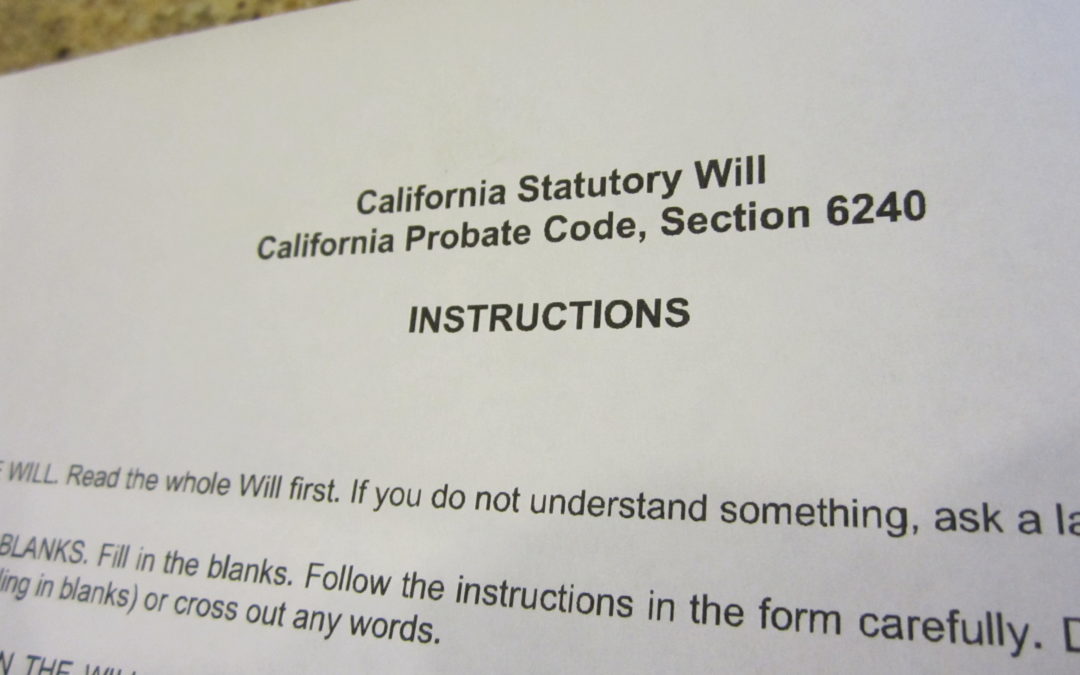by Andy Chen | Feb 13, 2019 | California, Estate Planning
A while back, I put a video out on my Youtube channel describing what a Power of Attorney (POA) is and what it can do for you. Here it is, in case you missed it. I also posted previously on this blog about what happens to a Power of Attorney in California when you get divorced and your spouse is your POA agent. In this post, I’m going to go over what happens when a POA that has been properly signed is, nonetheless, not recognized. For sake of illustration, let’s say that your elderly mother has signed a POA naming you as her agent. Your mom wants you to manage her money (e.g. pay her bills) and to do that, you need to access her bank accounts, but your mom’s bank is refusing to cooperate with you. What do you do? The California statute that applies here is Section 4406 of the California Probate Code. One important thing to recognize first, though, is that 4406 only applies to what are called “Uniform Statutory Powers of Attorney”. What this basically means is that 4406 doesn’t apply to any random POA that gets written up, even if it’s written up properly. 4406 only applies to the specific POA that is explicitly specified in the California Probate Code (specifically, section 4401). If you have a Uniform Statutory Power of Attorney in California and it’s been properly signed by the principal (see CA Probate Code section 4121) and a third-party (e.g. a bank, like in this hypothetical) is refusing to honor it, 4406 provides for the following: The agent can sue the third-party...

by Andy Chen | Jan 8, 2019 | California, Estate Planning, Family Law, Individual
I had a post before about what happens in California to your will after you get divorced. Many people have their spouses named in their will in some way (e.g. to be executor). In nearly all cases, I would imagine you don’t want your ex-spouse to have control over your estate when you’ve died. Today, though, I’m going to go over a similar question: what happens in California to your Power of Attorney or Durable Power of Attorney document after you’ve gotten divorced? As with wills, many people name their spouses as their power of attorney agent or durable power of attorney agent and, as with divorces, most people likely don’t want their ex-spouses having control over them once the divorce is finally over. The relevant law here is going to be Section 4154 of the California Probate Code, section (a) of which states: “If after executing a power of attorney the principal’s marriage to the attorney-in-fact is dissolved or annulled, the principal’s designation of the former spouse as attorney-in-fact is revoked.” Section 4154(b) then goes on to say that if divorce or annulment of the marriage was the only reason why the power of attorney was revoked, then remarriage of the principal and attorney-in-fact will reinstate the power of attorney and the attorney-in-fact’s authority under it. If, however, the power of attorney was revoked for other reasons too and the principal and attorney-in-fact just happened to get divorced at the same time, then them remarrying does not reinstate the power of attorney and the attorney-in-fact’s authority. If you compare what happens to a will under section 6122 of...

by Andy Chen | Jan 4, 2019 | California, Family Law, Individual
This post is going to be about what happens to assets that were not previously disclosed during a California divorce case. This failure to disclose could be intentional, such as your soon-to-be ex-spouse purposely trying to hide bank accounts and other property from you. For instance, suppose you were a stay-at-home mom and your husband was the one who worked outside the home. Even though all the property the two of you acquired during the marriage is likely going to be community property to which you would be entitled to half, he might view it as all rightfully belonging to him because he was the one who went out to work for it. He might, for example, try to hide it by putting it all under his brother’s name, his elderly mother’s name, etc. The failure to disclose could also be accidental. People can be forgetful, even when they intend to be honest. Depending on your level of wealth, the length of the marriage, etc, it is possible that your soon-to-be ex-husband, for example, might forget that he had a 401K from a job he worked 20 years ago that he has never touched. Theoretically, all assets and debts should be disclosed during a divorce and each party should — in theory — have total access to all information regarding the couple’s finances. The reality, of course, is never that perfect. The fact that financial disclosure during a California divorce is voluntary and on the honor system doesn’t help either. Bottom line: if you’re involved in a California divorce and you believe your soon-to-be ex-spouse is trying to hide...

by Andy Chen | Jan 2, 2019 | California, Estate Planning, Individual
After you get divorced, a lot of things happen automatically under California law. Many of these things have to do with estate planning. In this post, I’m going to go over how a divorce affects how California treats wills that either spouse has made. In previous posts, I’ve gone over how to make a will in California, how to disinherit your children in your California will, and how to omit your spouse in your California will. If you haven’t seen those posts, I encourage you to go take a look. The relevant law here for how a divorce affects a will is going to be in section 6122 of the California Probate Code. A very similar statute (Section 6122.1 of the California Probate Code) applies to domestic partnerships also. Under section 6122(a), the following happens automatically upon a divorce unless a will executed after the divorce provides otherwise: Disposition of property to the former spouse is revoked;Special and general powers of appointment conferred upon the former spouse are also revoked;Provisions specifying the former spouse as conservator, guardian, trustee, or executor are also revoked. In the event of a divorce, section 6122 treats the former spouse as if they had already died. In the event these spouses get remarried, however, section 6122(b) automatically reinstates/revives these same provisions of the deceased spouse’s will. As always, this post is not meant to be a comprehensive explanation of how a divorce might affect your will or the will in the particular situation you are dealing with. If you are outside of California or your situation doesn’t involve California at all, likely none of...
by Andy Chen | Oct 31, 2018 | California, Enterprise
A topic that often arises in the context of a business is non-compete agreements. As the name should hopefully suggest, a non-compete agreement is a contract in which a party agrees not to engage in a lawful profession, trade, or business. A non-compete agreement might arise with two potential competitors agreeing to divide a particular market between them. Collusion like this is generally illegal on, among other things, federal antitrust grounds which are waaaaaay beyond the scope of this blog post. The more common scenario I encounter involving non-compete agreements is where the restriction is not voluntary. A common scenario would be where an employee works for an employer who, deep in the legalese of the papers the employee signed when they hired on, forbids the employee from either going to work for a competitor or opening up a competing business. In other words, if the employee is fired or quits, they can’t go continue in the same line of work. The vast majority of people have experience, training, etc in only one line of work so the employer’s restriction effectively means that they cannot make a living if they upset their employer. Can an employer impose restrictions like this on an employee? In California, the answer – in general – is no and it is because of Section 16600 of the California Business and Professions Code. Section 16600 states: Except as provided in this chapter, every contract by which anyone is restrained from engaging in a lawful profession, trade, or business of any kind is to that extent void. As with everything in the law, of course, there...
by Andy Chen | Oct 29, 2018 | California, Criminal law, Individual
In California, arraignments are generally the first time that a criminal defendant makes their appearance in court. Every arraignment is slightly different because no two cases and no two courts are exactly the same. If you are facing misdemeanor criminal charges in California and want to learn more about what happens at an arraignment, I have video on my Youtube channel about it. Depending on the particular court you’re in, the judge you’re in front of, etc, you may have the option of doing something called a Clerk’s Arraignment instead. It is what it sounds like — you get arraigned in front of a court clerk (i.e. a non-judge who just works for the court) as opposed to an actual judge or court commissioner. Some of you might be going ‘Whoa, what? Is that legal?’ The answer is that it is, but – in my experience at least – it is not common. I would guess that I encounter it less than 10% of the time on misdemeanor cases. All of those are on cases where the defendant has his or her own attorney (i.e. not the public defender). I have never seen a Clerk’s Arraignment done in a case where the defendant is appearing without a lawyer. If you have, leave me a comment down below. There are many reasons why a Clerk’s Arraignment might be done. One is speed. For the vast majority of misdemeanor cases, arraignment is routine and uneventful for an attorney to do. Additionally, misdemeanors are very common so it is not unusual for an attorney to wait in line for 45 or more...



